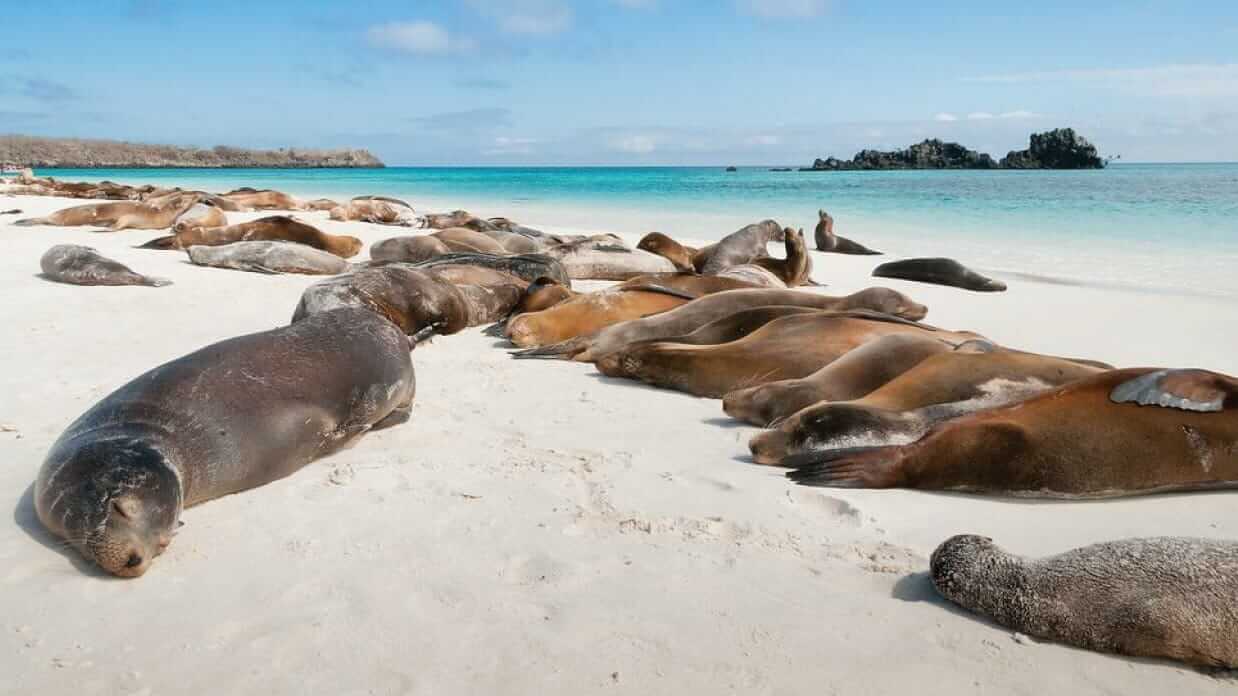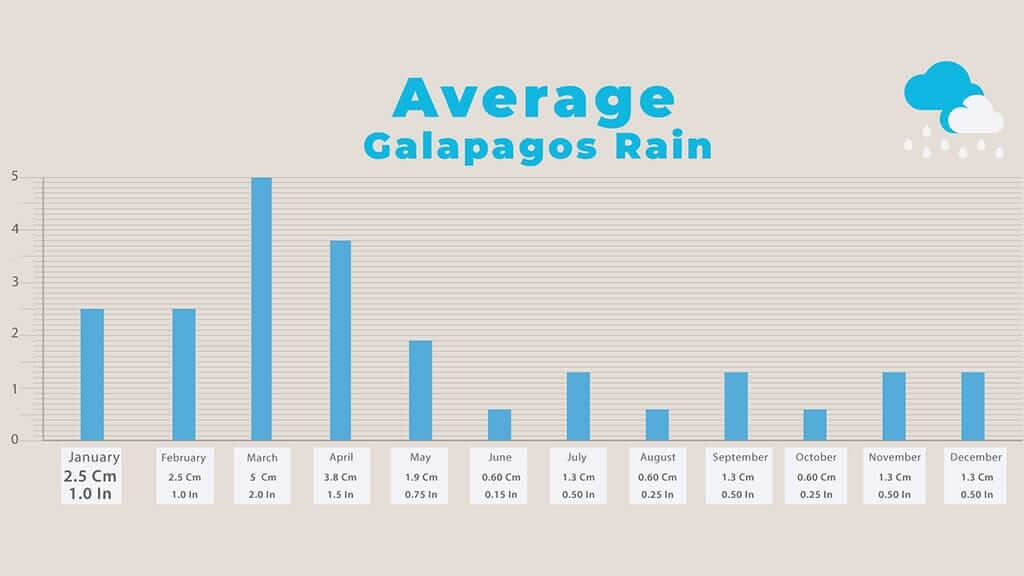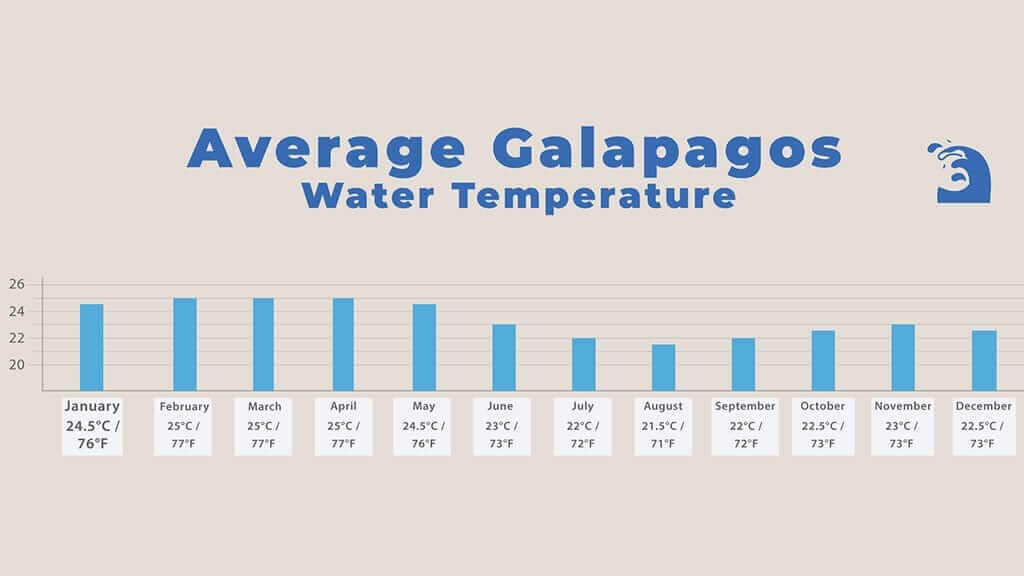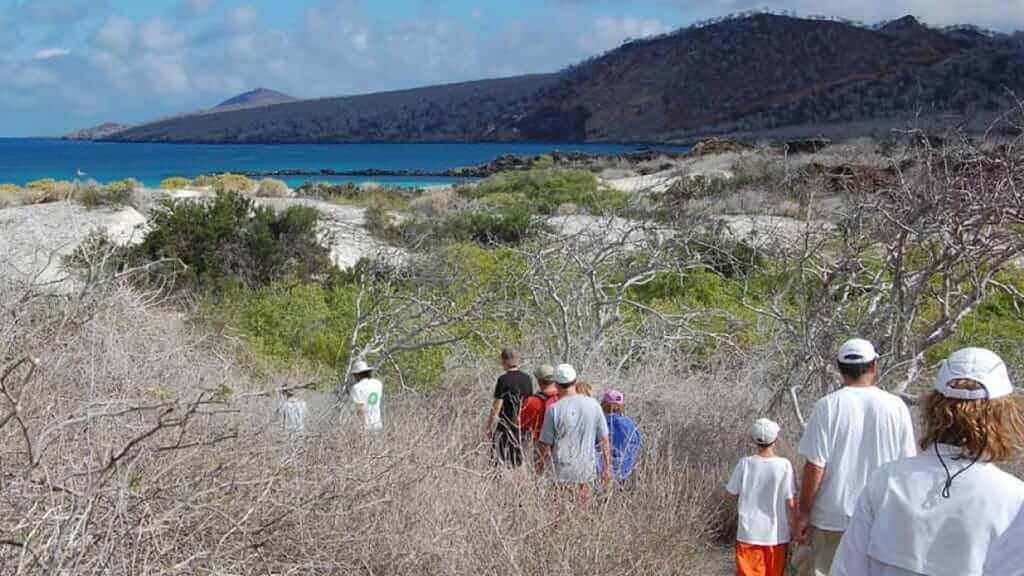GALAPAGOS WEATHER & CLIMATE
One of the most frequently asked questions when planning a Galapagos vacation is: WHEN IS THE BEST TIME TO VISIT GALAPAGOS?
While Galapagos weather does vary each month, there is no “best” or “worst” time for Galapagos travel. In fact, the Galapagos Islands are a fabulous year-round destination, with a pleasant climate throughout the year.
Even better, there are no Galapagos weather extremes to deal with. No snow or frost, no hurricanes, no extreme hot or cold temperatures.
That said, there are subtle differences in Galapagos weather each month. Trip planners will want to consider the Dry season vs. the wet season. There are also peak vs off-season tourist months to plan around. The famous Galapagos Islands wildlife follow climate seasons for nesting, mating, hatching & parenting - so, there's different action to see each month. Galapagos water temperature also varies through the year, with implications for snorkeling with/without a wetsuit. Each of these Galapagos climate factors can make a difference to your enjoyment of the archipelago.
Yes, it can be confusing, but fear not, we have prepared this Galapagos Weather & Climate blog post to help figure out when is the best month for your Galapagos Islands Trip.
So, keep reading for everything you need to know about Galapagos Weather throughout the year. We provide information about average air and water temperatures each month, average rainfall, as well as typical wildlife behavior. In a nutshell, everything that you'll need to plan the perfect vacation.
SECURE YOUR GALAPAGOS TRAVEL
Get a FREE personalised quote today
Galapagos Islands Weather: A Tale of Two Seasons
What is the weather like in the Galapagos Islands?
Broadly speaking there are 2 different Galapagos Weather seasons:
1. Warm & Wet.
2. Cool & Dry.
Although the climatic differences between each season can be quite subtle it does greatly impact life at the Galapagos.
Don't worry, in both Galapagos weather seasons, you'll still get to see all of the wonderful wildlife and stunning volcanic panoramas. But it does pay to understand the differences during trip planning. The Galapagos islands are a once-in-a-lifetime experience, so you want to get it right!
Here is a summary of what to expect in each Galapagos climate season:
Galapagos Warm & Wet Season
The WARM & WET Galapagos weather season runs from December/January through to May.

Galapagos weather in the warm and wet season is sunny and warm, but also occasionally wet. So visitors can expect plenty of sun rays, and warm temperatures on land and in the sea. The downside is the risk of occasional rain showers.
So, you'll probably go home with a healthy tan, but sun protection is a must to prevent sunburn. Rain gear is also recommended for island excursions, especially up in the highlands.
The rains are very welcome for wildlife in the Galapagos highlands, bringing a dramatic transformation to their habitat. Wet Galapagos weather produces lush green vegetation - the perfect conditions for land species such as the Giant Tortoise, Galapagos Finches & other land birds who find food sources plentiful in this season.
Galapagos marine species are also easily spotted during the warm and wet season, even though the warmer sea temperatures are not their ideal conditions for feeding or breeding.
Galapagos Cool & Dry Season
The Galapagos COOL & DRY climate season runs approximately from June to December.

The Cool & Dry Galapagos weather season brings cloudier skies, cooler temperatures on land and at sea, and a dry climate. Many visitors find this season to be more pleasant for excursions. Sun protection is still important – even on cloudy days it's easy to burn your skin this close to the equator. A wetsuit is recommended for snorkeling as the sea temperatures drop. It's usually safe to leave your rain gear at home, there is little or no rainfall during this Galapagos climate season.
Now it's time for the Galapagos marine species to shine. The cold Humboldt current brings rich nutrients from the Antarctic to Galapagos waters. These are optimal conditions for Galapagos Sealions, Marine iguanas, Sharks, and Seabirds like the blue-footed booby and Waved Albatross. Migratory whale species are also attracted to the Galapagos islands to feed.
In contrast, the lack of rain leaves the highlands bare. You'll still see plenty of Galapagos land creatures, but the plants and flora are waiting for the return fo the rains.
Remember, both Galapagos Islands weather seasons are great times to visit. There truly is no best or worst season, it all comes down to personal preference. Whichever month you choose to travel you'll have an unforgettable trip!
Galapagos Weather By Month
Now, let's take a deep dive into Galapagos weather by month.
Check out the graphs below for a quick and easy comparison of the main Galapagos climate statistics.
Galapagos Islands Temperature By Month

When is the warmest month in Galapagos? March and April boast the top average Galapagos temperatures with an average of 31 degrees Celsius (88 Fahrenheit). January and February clock in not far behind. So if you want to show off a post-trip suntan then these are the best months to travel.
When is the coldest month in Galapagos? All of the months from June through to December average out at 26 Celcius (79 Fahrenheit). Many visitors in fact prefer these cooler temperatures, which can be more comfortable for Galapagos treks and excursions.
Galapagos Islands Rainfall By Month

When is the rainiest month in Galapagos? March is the rainest Galapagos month with an average of 2 inches of rain (5cm), closely followed by April, then January and February. During these months expect occasional Galapagos rain showers, but certainly nothing to spoil your plans. If you prefer to avoid wet weather then it's best to travel to Galapagos during the dry season from June to December.
GET FREE ADVICE
From a Galapagos destination expert todayGalapagos Isdlands Water Temperature By Month

Galapagos islands weather
How cold is the water in Galapagos? The Galapagos water temperature varies from a low of 21.5 Celcius (71 Fahrenheit) in the dry season, to a high of 25 Celcius (77 Fahrenheit) in the wet season at the start of the year.
Do I need a wetsuit in Galapagos? It really depends on your tolerance to different water temperatures. Most Galapagos visitors choose to wear a wetsuit when snorkeling from June through to December. The Galapagos water temperature from January to May is warmer so many tourists snorkel without wetsuits. Wetsuit rentals are available on many Galapagos yachts for those who need them.
Galapagos Islands Weather Affects Wildlife Behaviour
Changes in Galapagos weather patterns bring changes in wildlife behavior. While every month at the Galapagos offers unbelievable wildlife spotting opportunities, each different month has something special & unique going on for visitors to enjoy.
Wildlife nesting, mating, hatching, and parenting behavior of different species will often be a highlight of your trip. That's why we have written a separate detailed blog for each month of Galapagos Weather. Just click on each month to learn more about wildlife behavior highlights throughout the year.
January, February, March, April, May, June, July, August, September, October, November, December

Most of the iconic Galapagos wildlife species live here year-round, but there are also a few Migratory Species that can only be spotted during specific months. The Galapagos Albatross is a great example, nesting on Espanola island only from April to December each year. Similarly, Galapagos whale watching is best from May to December. There are also a number of migratory shore and wader bird species.
So do check carefully if there is a specific animal that you want to see - if in doubt then just ask us, our expert staff will be happy to help out.
When is the Galapagos Islands Tourist High Season?
Besides the Galapagos weather patterns, there is one more important consideration to deciding 'When is the best time to go to the Galapagos?'. That is the Galapagos tourist demand season.
Galapagos Tourist High Season.
During the Galapagos high season, you should expect larger visitor crowds, less cruise availability, and higher vacation prices, so it's best to avoid high season if you can.
When is Galapagos high season? Broadly speaking it follows the school/college vacations. So July & August are busy, as is Easter week, and Christmas / New Year. During these times we strongly recommend booking well in advance to avoid missing out. The earlier that you can book, the better.

Local Ecuadorian public holidays such as Carnaval (February or March) and All Saints & Souls (November) are also popular dates when Galapagos Islands flights often sell out.
Most other months of the year are considered to be Regular Galapagos Season. September and October at the Galapagos often have the lowest tourist demand, so can be good months to avoid the crowds.
If you need help planning your Galapagos Vacation, then just drop us a line. We will be happy to help you choose the perfect month for your trip and send a FREE GALAPAGOS TOUR QUOTE.
Happy Gringo Travel has over 19 years of experience as the trusted choice in Galapagos travel and has been awarded the TripAdvisor Certificate of Excellence for 7 consecutive years. We specialize in Galapagos Cruises, Scuba Diving Tours, as well as Galapagos Land Trips.
Book With The #1 Trusted
Galapagos Travel Agency
In conclusion, when is the best time to go to Galapagos? Every month is amazing at the Galapagos islands! Galapagos weather is enjoyably pleasant throughout the year, and the wildlife action never disappoints. But, we do always recommend you take some time during trip planning to compare Galapagos weather months and seasons. Galapagos Islands' climate differences, even though subtle, can make a significant difference to your trip.
So, what are you waiting for? Now that you know what to expect, it's time to get tickets booked and bags packed. Come on over, let's put a nice, big tick onto your travel bucket list!
